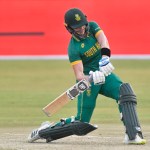Sport
What U-19 World Cup campaign tells us about the future of South African cricket

South Africa’s youngsters team has had a disastrous World Cup and while the first instinct is to call for manning the panic stations, there’s a far bigger lesson CSA can take from the tournament. By ANTOINETTE MULLER.
Anyone who has been following the Under-19 World Cup has probably sent out an SOS to man the panic stations. South Africa’s results make for pretty grim reading: Played five, lost three, won two. Those three losses came against Bangladesh, Namibia and Zimbabwe.
Having won the trophy at the previous edition in 2014, many will be cringing at the most recent results. Combine this depressing reading with the continued beating the senior team is taking at the hands of England and you will understand why the public is convinced that cricket in South Africa is in the doldrums.
But – here’s the thing about age-group World Cups – they are a minefield for consistency because players inevitably change all the time as they progress from their age groups. Using the phrase “defending their title” is a fallacy as things simply change too much from one World Cup to the next. The squad will never be the same and only occasionally will a player feature in consecutive tournaments. It is also not necessarily a reflection of who might be a future Protean.
For example, Graeme Smith represented South Africa at two age-group World Cups. In his first tournament, Jacques Rudolph, Johan Botha, Albie Morkel and Thami Tsolekile are the only players who went on to earn an international cap. You can add Jonathan Trott to the list if you’re counting non-South African caps. In the year following that, only Hashim Amla, Rory Kleinveldt, Imraan Khan and Ryan McLaren went on to play international cricket. The tournament after that when South Africa lost to Nepal, Colin Ingram, Vernon Philander, Vaughn van Jaarsveld and Roelof van der Merwe all earned international colours.
The 2006 edition produced Dean Elgar, Richard Levi and Wayne Parnell as well as England’s Craig Kieswetter while 2008 also featured Parnell along with Reeza Hendricks and Rilee Rossouw. In 2010, the world got its first taste of Quinton de Kock and he remains the only player from that squad as well as the 2012 squad to earn an international cap. These squads tend to ebb and flow and while players might play internationally, they do so with varying degrees of success.
It is also not unusual for up to 30 to 40 percent of players who feature at age group level to completely stop playing cricket all together. From the squad that won the World Cup in 2014, a fairly large group (nine out of fifteen) are still playing cricket in some way, but just one, Kagiso Rabada, has set the world alight.
Still, achieving consistency in these sorts of tournaments is not impossible. In his eight years in charge of the Under-19 team, former coach Ray Jennings oversaw just four losses at World Cups as players came and went through the revolving age group door. In April of 2014, following South Africa’s World Cup victory, Jennings was cut loose by Cricket South Africa as a result of “restructuring” the position.
This was a bold move in their never-ending quest for transformation in all age groups and realising the needs to start from the bottom. The “developmental” role, was created to focus on cricket from Under-13 to Under-19 players while the other was to focus on the “academy” side, helping players transition from age group to semi-pro. Although Jennings applied for the developmental role he did not get the job and, considering his track record, he probably had reason to feel aggrieved.
Lawrence Mahatlane, former Lions assistant coach, was appointed to the role and things have been grim under his watch. South Africa have lost 19 out of their 24 ODIs and drawn two of their Tests. That’s a pretty grim record, but a good coach can only do so much with an ever-changing squad. The age of these players mean that many will be in their final year at school and might miss out on important tours as school work takes preference over sporting excellence and the pool from which to select is restricted.
This makes what Jennings achieved only all the more remarkable. The Jennings way has always been that of an old school headmaster. He focusses on intense discipline and preparation and, if you get it wrong, you are in trouble. There’s a famous story of him taking away the sandwiches of the Easterns squad for underperforming and making them do shuttle runs to repent. His reasoning was that “you get paid for four days, so you should work for four days.”
This kind of military discipline does not gel with everyone and to this day, Jennings does not believe Quinton de Kock is cut out to be a professional cricketer, because he lacks the discipline required to do so. His no-nonsense approach is clearly missed, but the top performers at South Africa’s disastrous Under-19 World Cup tells a story that’s often missed.
South Africa’s top performers still come from South Africa’s top cricket schools. Kyle Verreynne, Wiaan Mulder and Liam Smith, who all put in decent efforts come from Wynberg, St Stithians and King Edward VII. The bulk of South Africa’s Under-19 players also come from schools that are recognised as some of the country’s “best”. There are a few exceptions, but all the schools from which the players come from will be considered “good sporting schools”. This trend translate to the senior team, too.
Since South Africa’s readmission in 1992, 57 different schools have produced 91 Test cricketers, but 50 of those players have come from the same 18 schools. KES (six), Grey College (five) and Durban High School (four) feature most prominently while Affies, Grey High, Hoërskool Vereeniging, Plumstead, SACS and Rondebosch have all produced three players. All bar two of these schools (Vereeniging and Plumstead) are known for their sporting prowess. They have the best facilities, the best coaches and thus, produce the most cricketers. Vereeniging, which schooled the Morkel brothers as well as Tertius Bosch, and Plumstead, which produced Paul Adams, JP Duminy and Rory Kleinveldt, are the only two anomalies.
The odds of becoming a professional sportsman will forever be higher if you go to a good school – whether you play Under-19 cricket or not and when transformation is a priority, this is a part of the programme that is often overlooked.
Access to resources remains the biggest stumbling block when it comes to transformation in South African sport. These resources range from the obvious such as facilities and kit, but also extend to things like coaching and nutrition. Even simple things like poorer schools or clubs just having the opportunity to play fixtures is rarely considered when transformation is discussed. The vast majority of South Africa’s population simply do not have these luxuries and the roll out of facilities has been stagnant in some of South Africa’s rural areas.
Players who make it to elite level – black or white – almost always attended a “cricket school” or, at the very least, played at a school or club with a very good coach.
Thus, the lesson to heed from this campaign is that while Jennings is the kind of no-nonsense father figure that can create miracles out of nothing, sporting excellence cannot rely on miracle workers alone. South Africa has always had enough talent to filter through and rise to the top but if they want to remain world beaters for years to come, overall development at schools across the country- those with resources and without- might need a rethink. DM
Photo by Reuters.



















 Become an Insider
Become an Insider